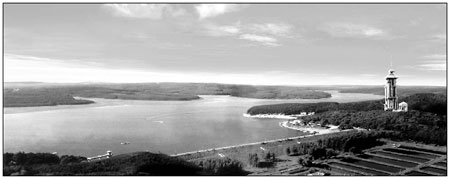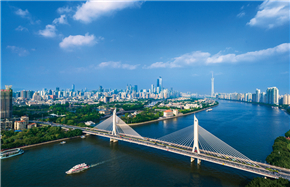Service industry backed by forests, rivers, and lakes
|
View of Jingyuetan National Forest Park, in the southeastern part of Changchun, Jilin province. |
The Jingyue Economic Development Zone in the city of Changchun, Jilin province, is both a pioneer in the modern services sector and a place with a splendid environment.
It is located in the southeastern part of the city, facing a 112-square-kilometer forest park to the east. To the south, there is a 107-sq-km reservoir and to the west, the Yitong River, formerly an important water channel for the city.
It covers a 478.7-sq-km area, or about the same size as the urban area, that has five rivers and eight small reservoirs, leaving more than half of it covered by forests and water. This is something that is rarely seen elsewhere in China's economic zones.
The zone was recognized as a national pilot zone for the service sector, last August.
In 2009, it had a GDP of 27.7 billion yuan ($4.24 billion), 19.4 billion of that contributed by the service sector, or more than 70 percent of the total.
Service industries there attracted nearly 70 billion yuan in investments, in the five years since 2005, accounting for more than 80 percent of the zone's total investment.
It has a number of projects funded by renowned enterprises like Qiming Information Technology Co Ltd, Charter Shopping Center, South Korea's SK Holdings, and Malaysia's Mulia Group.
The high-tech sector holds a prominent place in the zone, with a 10-sq-km optoelectronics industrial park for optoelectronics, new energy, and software outsourcing.
The parks projects include an auto design center, an online support system for small and mid-sized enterprises, and an R&D center for LED products backed by Taiwan's Genius Electronic Optical.
Around 30 companies plan to set up headquarters in the zone and the local government wants to build a regional business management hub for northeastern Asia.
It draws resources from 15 schools that include Northeast Normal University, Jilin Agricultural University, and Jilin University of Finance and Economics, with 170,000 students and faulty in all.
There are also nearly 10,000 people working in the zone's eight research institutes.
The zone is thinking green and the local government is keeping an eye on the low-carbon sector. One large power generation company, the China Datang Corp, will have a wind power-related project there, and bases for energy-trading, new energy vehicles, and low-carbon products will be built.
The local government is welcoming investment and has an innovative mechanism for that, consisting of local enterprises, colleges, research institutes and intermediary agencies.
"We'll have an integrated plan for investment," said Guan Shusen, head of the zone's administration committee, "we'll focus on several major countries and regions, and have major targets."
These targets include multinationals and large Chinese companies.
A special 100-million-yuan fund has been organized to help develop service companies, and that is expected to grow in the coming years.
There are also plans to put an additional 5 billion yuan into infrastructure, such as roads, green lands, parks and the water system, over the next five years.
Two new wetland parks are also planned alongside the Yitong River, each covering more than 3 sq km. Eighteen new theme parks and green lands will also be built in the zone.
(China Daily 04/20/2011 page14)















